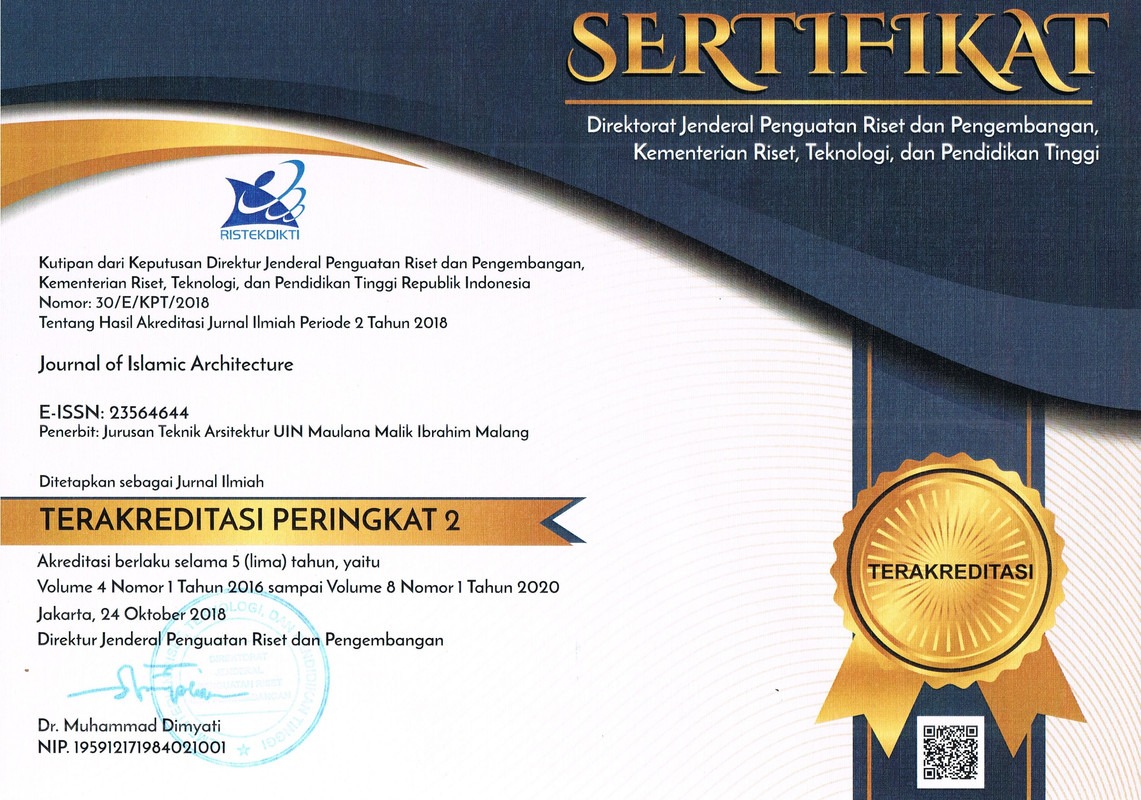REACHING THE UNDERSTANDING OF THE GREEN BUILDING CONCEPT IN ISLAMIC VALUE: THEMATIC TAFSEER STUDY
Abstract
This research is significant to fill the gaps in the development of green building concepts that give an emphasis to the technical strategies or solutions. This study used the thematic Quranic interpretation method (maudhu'i). It was done by collecting verses from the Quran related to the environment in general, specifically using quantitative content analysis. The result shows that there are two significant main categories stated for greenship based on thematic, mainly ASD and WAC. It reaches the most vital points. It is 56.1% points of ASD and 28.5% of WAC. It is expected that, by applying this approach, the green building concept will be much easier to be accepted, understood by human being as caliphs, and implemented as well as possible.
Keywords
Full Text:
PDFReferences
R. J. Cole and A. Oliver, Low Energy Low Carbon Architecture Recent Advances & Future Directions. London: CRC Press, 2016.
T. Woolley and R. Harrison, Green Building Handbook: A Guide to Building Products and Their Impact on the Environment. New York: Spon Press, 2005.
Y. Jabareen, "A New Conceptual Framework for Sustainable Development," Environ. Dev. Sustain., vol. 10, pp. 179–192, 2008, doi: 10.1007/s10668-006-9058-z.
J. Mensah, "Sustainable development: Meaning, history, principles, pillars, and implications for human action: Literature review," Cogent Soc. Sci., vol. 5, no. 1, 2019, doi: 10.1080/23311886.2019.1653531.
R. L. Killawi, Sustainable Development from Islamic Perspective, 1st ed. Dubai: Islamic Affairs & Charitable Activities Department, 2014.
A. F. Muchlis, D. Larasati, and S. Sugeng Triyadi, "Sustainable Development and Architecture: A Conceptual Based on Religious Perspectives," Int. J. Adv. Res. Eng. Technol., vol. 11, no. 4, pp. 1–6, 2020, doi: 10.34218/IJARET.11.4.2020.001.
A. Darko and A. P. C. Chan, "Critical analysis of green building research trend in construction journals," Habitat Int., vol. 57, pp. 53–63, 2016, doi: 10.1016/j.habitatint.2016.07.001.
I. M. C. S. Illankoon, V. W. Y. Tam, K. N. Le, and L. Shen, "Key Credit Criteria Among International Green Building Rating Tools," J. Clean. Prod., vol. 164, pp. 209–220, 2017, doi: 10.1016/j.jclepro.2017.06.206.
M. Ali, P. Miraj, and R. Windrayani, "Stakeholders’ perspectives on green building rating: A case study in Indonesia,” Heliyon, no. August 2018, p. e01328, 2019, doi: 10.1016/j.heliyon.2019.e01328.
Sahid, Y. Sumiyati, and R. Purisari, “The Direction of Developing Green Building Criteria in Indonesia,” J. Phys. Conf. Ser., 2021, doi: 10.1088/1742-6596/1811/1/012090.
A. F. Muchlis, D. Larasati, S. Sugeng Triyadi, Y. Hanifah, A. Wardhani, and N. Ekawati, “Development of Green Building Ranking Based on Stakeholders Values Using the AHP,” IOP Conference Series: Earth and Environmental Science, vol. 738, no. 1, 2021, doi: 10.1088/1755-1315/738/1/012009.
S. H. Alyami, “Critical Analysis of Energy Efficiency Assessment by International Green Building Rating Tools and Its Effects on Local Adaptation,” Arab. J. Sci. Eng., vol. 44, No. 10, pp. 8599-8613, 2019, doi: 10.1007/s13369-019-03972-x.
Z. Gou and S. S.-Y. Lau, “Contextualizing green building rating systems: Case study of Hong Kong,” Habitat Int., vol. 44, pp. 282–289, 2014, doi: 10.1016/j.habitatint.2014.07.008.
H. H. Ali and S. F. Al, “Developing a green building assessment tool for developing countries – Case of Jordan,” Build. Environ., vol. 44, no. 5, pp. 1053–1064, 2009, doi: 10.1016/j.buildenv.2008.07.015.
M. A. Khan, C. C. Wang, and C. L. Lee, “A Framework for Developing Green Building Rating Tools Based on Pakistan’s Local Context,” Buildings, vol. 11, no. 202, 2021.
J. L. Wilson and E. Tagaza, “Green Buildings in Australia : Drivers and Barriers,” Aust. J. Struct. Eng., vol. 7 No 1, April 2006, doi: 10.1080/13287982.2006.11464964.
A. Darko, C. Zhang, and A. P. C. Chan, “Drivers for green building: A review of empirical studies,” Habitat Int., vol. 60, pp. 34–49, 2017, doi: 10.1016/j.habitatint.2016.12.007.
H. Nguyen, M. Skitmore, M. Gray, and X. Zhang, “Will green building development take off ? An exploratory study of barriers to green building in Vietnam,” Resour. Conserv. Recycl., vol. 127, no. May, pp. 8–20, 2017, doi: 10.1016/j.resconrec.2017.08.012.
M. Wimala, E. Akmalah, and M. R. Sururi, “Breaking Through the Barriers to Green Building Movement in Indonesia: Insights from Building Occupants,” Energy Procedia, vol. 100, no. September, pp. 469–474, 2016, doi: 10.1016/j.egypro.2016.10.204.
Y. Li, L. Yang, B. He, and D. Zhao, “Green building in China : Needs great promotion,” Sustain. Cities Soc., vol. 11, pp. 1–6, 2014, doi: 10.1016/j.scs.2013.10.002.
C. Jabbour, N. Kasai, and C. Jose, “Barriers to green buildings at two Brazilian Engineering Schools,” Int. J. Sustain. Built Environ., vol. 3, pp. 87–95, 2014, doi: 10.1016/j.ijsbe.2014.05.004.
W. D. T. Y. Li. T. Y.-T. Tang, “Barriers and policy recommendations for developing green buildings from local government perspective,” Intell. Build. Int., vol. 10, no. 2, 2016.
E. M. Ghazali, D. S. Mutum, and N. Ariswibowo, “Impact of Religious Values and Habit on an Extended Green Purchase Behaviour Model,” Int. J. Consum. Stud., no. July, pp. 639–654, 2018, doi: 10.1111/ijcs.12472.
A. H. Ansari, P. Jamal, and U. A. Oseni, “Sustainable Development: Islamic Dimension with Special Reference to Conservation of the Environment,” Adv. Nat. Appl. Sci., no. January, pp. 607–619, 2012.
M. Ebrahimi and K. Yusoff, “Islamic Identity, Ethical Principles and Human Values,” Eur. J. Multidiscip. Stud., vol. 6, no. 1, p. 325, 2017, doi: 10.26417/ejms.v6i1.p325-336.
Badan Litbang dan Diklat Departemen Agama RI, Tafsir Al-Qur’an Tematik: Pelestarian Lingkungan Hidup. Jakarta, 2009.
A. Misni, “The Effects of Surrounding Vegetation, Building Construction and Human Factors on The Thermal Perfomance of Housing in A Tropical Environment,” thesis, Victoria University of Wellington, 2012.
H. Hoyle, J. Hitchmough, and A. Jorgensen, “Landscape and Urban Planning Attractive, Climate-Adapted and Sustainable? Public Perception of Non-Native Planting in the Designed Urban Landscape,” Landsc. Urban Plan., vol. 164, pp. 49–63, 2017, doi: 10.1016/j.landurbplan.2017.03.009.
DOI: https://doi.org/10.18860/jia.v6i4.12742
Refbacks
- There are currently no refbacks.







